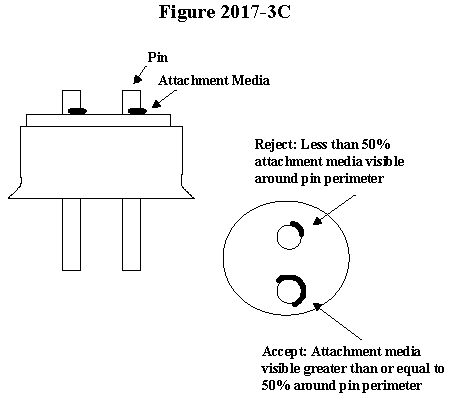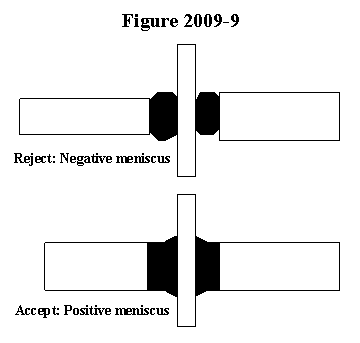
Why test?Testing the Chips
The chips that Hughes was manufacturing for the U.S. government were being used in a range of military programs some of which involved aircraft and missiles that traveled at high altitudes at supersonic speeds. Chips that were in these aircraft or missiles were exposed to dramatic ranges of temperature, moisture, and physical shock. So, a chip that worked fine now might not work fine after two years of exposure to the sort of abuse that regular flight exposed it to. The seal might begin to break, or solder links might crack, and the chip would begin to malfunction.
So, the chips had to be tested not only for whether or not they worked correctly, but for whether or not they held up to standard in terms of their seal or their resistance to heat and shock. The records that Hughes kept regarding their testing showed that approximately 10% of the chips tested failed one or more tests. When a test fails, it does not mean the chip is bad. It might work fine, in fact. But if the seal is broken, water or air might get in over time and corrode the connections on the chip.
As mentioned before, the two whistleblowers noticed that Hughes was not fulfilling its military contract in testing its hybrid microcircuits. The two whistleblowers worked as supervisors of hybrid quality assurance and seals processing in the environmental testing area respectively. They were present when Hughes omitted tests, ran tests out of order, authorized re-work on chips that had failed tests, and falsified documents thereby covering up the fraud.
The Tests
The 4 test areas that were specifically mentioned in case documents as places where Hughes fell short of their contract were Temperature Cycle, Constant Acceleration or Mechanical Shock, Hermeticity (Fine-Leak and Gross-Leak Tests) and the P.I.N.D. Test.
These test descriptions are taken from MIL-STD-883, a more recent version of the test standards than was used during Hughes manufacture in the mid-80s. Although it is possible that some of the testing standards have changed some since Hughes was prosecuted for faulty procedures, all of the basic tests described in the civil complaint are still required today. MIL-STD-883 and can be downloaded in its entirety (641 pages) in PDF format at this web address: http://www.dscc.dla.mil/Programs/MilSpec/listdocs.asp?BasicDoc=MIL-STD-883
or at http://www.dscc.dla.mil/
and link to the Military standards page. Search for
MIL-STD-883 on the search engine linked at the bottom of the first Military
Standards page.
Precap Visual Inspection: Method 2017
"The purpose of this test is to visually inspect the internal materials, construction, and workmanship of hybrid, multichip and multichip module microcircuits. This test will normally be used on microelectronic devices prior to capping or encapsulation on a 100 percent inspection basis to detect and eliminate devices with internal defects that could lead to device failure in normal application." The diagrams from this method detail many errors that could have occurred during the microcircuit construction process: bonding, wiring, adhesive, configuration and other problems. One example is Figure 2017-3c Package Post Criteria. As you can see, the top pin is not attached properly because the attachment media is not visibly surrounding 50% or more of the pin’s perimeter. [27].

Stabilization Bake: Method 1008
"The purpose of this test is to determine the effect on microelectronic devices of storage at elevated temperatures without electrical stress applied." There are nine minimum temperatures and time conditions that hybrid microcircuits can be subjected to. They are all equivalent to one another, but vary in length and intensity. Three examples of valid conditions are 100 degrees C for 1,000 hours, 160 degrees C for 16 hours, or 200 degrees C for 6 hours. End-point measurements are then run on the hybrids after they have been removed from the heating apparatus within 96 hours.
Temperature Cycle: Method 1010
"This test is conducted to determine the resistance of a part to extremes of high and low temperatures, and to the effect of alternate exposures to these extremes." The hybrids are cycled between two extremes in temperature. One cycle starts when a hybrid is subjected to —65 degree C temperature between 10 and 15 minutes. Then the hybrid is transferred in less than a minute to a temperature of +150 degrees C for 10 to 15 minutes. The transfer time remains less than a minute when it completes the hot section and is returned to the cold section. This one cycle is repeated a minimum of 10 times.
If the number of interruptions (failure in machinery, failure to transfer the hybrid between cycles in less than a minute, etc.) exceed 10% of the total number of cycles run, the test must be completely restarted. "Failure of end-point measurements, evidence or damage to the case, leads, seals or illegible markings shall be considered a failure."
Constant Acceleration: Method 2001
"This test is used to determine the effects of constant acceleration on microelectronic devices. It is an acceleration test designed to indicate types of structural and mechanical weakness not necessarily detected in shock and vibration tests. It may be used as a high stress test to determine the mechanical limits of the package, internal metallization and lead system, die or substrate attachment, and other elements of the microelectronic device."
The hybrid is oriented respectively at X1, X2, Y1, Y2, Z1 and Z2 (as if on a 3- dimensional plane). For each orientation, it is spun around in a centrifuge machine for 1 minute at 30,000 gravity units (g’s).
"The shock test is intended to determine the suitability of the devices for use in electronic equipment which may be subjected to moderately severe shocks as a result of suddenly applied forces or abrupt changes in motion produced by rough handling, transportation, or field operation. Shocks of this type may disturb operating characteristics of cause damage similar to that resulting from excessive vibration, particularly if the shock pulses are repetitive."
The hybrid subjected to 5 shock pulses at a 1,500 g level lasting .5 ms each. This procedure is repeated in the X1, X2, Y1, Y2, Z1, and Z2 orientations. "After subjection to the test, failure of any specified measurements or examination, evidence of defects or damage to the case, leads, or seals, or illegible markings shall be considered a failure.
"The purpose of this test is to detect loose particles inside a device cavity. The test provides a nondestructive means of identifying those devices containing particles of sufficient mass that, upon impact with the case, excite the transducer."
The hybrid is subjected to series of 4 alternating 1,000+ or — 200-g peak shocks and 20 g peak at 40 to 250 Hz vibrations. Visual indication of high frequency spikes, audio indication of clicks, pops, and rattling, and more complicated electronic measures on a noise detector which exceed the normal background white noise level indicate a failure. Rejects shall not be re-tested.
In the Hughes case, these were referred to as the Fine- and Gross-Leak Tests. In MIL-STD-883E it is referred to as the Seal Test. Whatever its name, "the purpose of this test is to determine the effectiveness (hermeticity) of the seal of microelectronic and semiconductor devices with designed internal cavities."
The hybrids are put through a perfluorocarbon gross leak test, penetrant dye gross leak test, or weight gain gross leak test simply to find out if they are not in an airtight container. The fine-leak tests, which follow one or all of these gross leak tests, are some variation on a tracer gas (He) fine leak test. Examples of failure criteria for the tests involve a leak rate that is too fast, or weight gain, bubbles escaping from the seal, or evidence of dye penetration into the seal.
"Devices which fail gross leak may be re-tested destructively. [This means the device can be broken open, resealed, and then retested -computingcases editor] If the retest shows a device to pass, that was originally thought to be a failure, then the device need not be counted as a failure…Devices which fail fine leak test conditions shall not be re-tested for acceptance unless specifically permitted by the applicable acquisition document."
Pre Burn-In Electrical
This is just a test in which the hybrid is tested to see if it functions the way it is supposed to function under normal conditions following all of the previous tests. It is not submitted to any adverse conditions.
Burn-In: Method 101
"The burn-in test is performed for the purpose of screening or eliminating marginal devices, those with inherent defects or defects resulting from manufacturing aberrations which cause time and stress dependent failures. It is the intent of this screen to stress microcircuits at or above maximum rated operation conditions or to apply equivalent screening conditions which will reveal time and stress dependant failure modes with equal or greater sensitivity."
Final Electrical Test
This test is the same as the Pre-Burn-In Electrical test. The hybrid is tested to see if it functions the way it is supposed to function under normal conditions following all of the previous tests. It is not submitted to any adverse conditions.
Final Visual Inspection: Method 2009
"The purpose of this test method is to verify the workmanship of
hermetically packaged devices. This test method shall also be utilized
to inspect for damage due to handling, assembly, and/or test of the packaged
device." This test is performed on hybrids when they are about to
leave the factory, or have just entered another factory as a finished
product. Much like the Precap Visual inspection, this method mainly details
specific visual details that result in accepting or rejecting a hybrid.
One example is Figure 2009.9 Reentrant Seals. As you can see, only seals
with a positive meniscus are not rejected. [27]. 